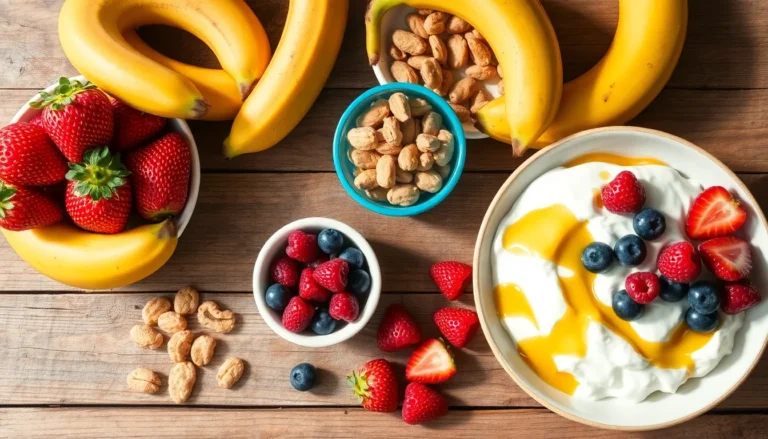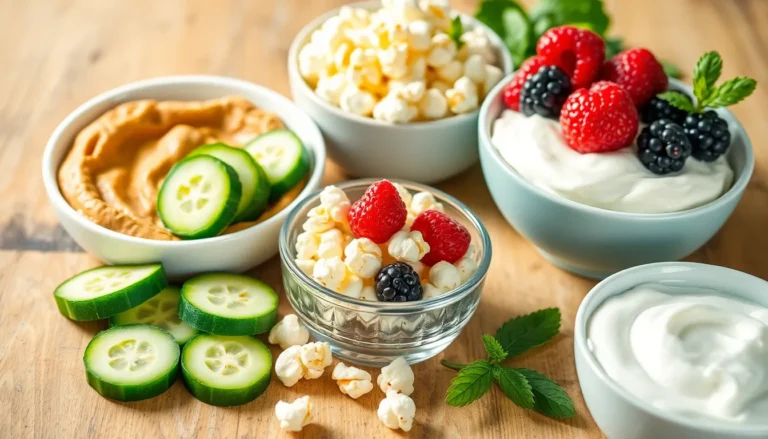Table of Contents
ToggleIn a world where fast food reigns supreme and snacks seem to call our names, high-fiber foods are the unsung heroes of a healthy diet. They’re like that friend who always reminds you to wear sunscreen—often overlooked but essential for keeping everything running smoothly. Fiber’s not just a buzzword; it’s a powerhouse that can help with digestion, weight management, and even heart health.
Imagine biting into a crunchy apple or savoring a hearty bowl of oatmeal. Not only do these foods taste great, but they also pack a punch in the fiber department. So why not embrace the fiber revolution? It’s time to fill up on these delightful foods that’ll have your gut singing and your body thanking you. After all, who wouldn’t want to be the proud owner of a happy, healthy digestive system?
What Are High-Fiber Foods?
High-fiber foods contain significant amounts of dietary fiber, which aids digestion and offers numerous health benefits. These foods can be classified into two categories: soluble and insoluble fiber. Soluble fiber dissolves in water, creating a gel-like substance that slows digestion. Foods rich in soluble fiber include oats, beans, and apples. Insoluble fiber adds bulk to stool and helps food pass through the digestive tract. Whole grains, nuts, and vegetables are excellent sources of insoluble fiber.
Many health organizations recommend a daily fiber intake of 25 grams for women and 38 grams for men. Achieving these targets requires incorporating various high-fiber foods into daily meals. Fruit like pears, berries, and bananas often contribute significant fiber content. When it comes to vegetables, broccoli, carrots, and Brussels sprouts lead in fiber-rich options.
Legumes such as lentils, chickpeas, and black beans also provide substantial amounts of fiber. Additionally, whole grains like quinoa, barley, and brown rice offer excellent nutritional benefits alongside their fiber content. Snacking on popcorn or including chia seeds and flaxseeds in recipes can enhance fiber intake.
Regular consumption of high-fiber foods supports overall health by promoting satiety and reducing the risk of chronic diseases. Emphasizing fiber in the diet can bolster heart health, improve bowel regularity, and assist in weight management. Thus, incorporating a variety of high-fiber foods is essential for maintaining optimal health and well-being.
Health Benefits of High-Fiber Foods

High-fiber foods offer numerous health benefits, impacting various aspects of well-being. Increased fiber intake significantly enhances overall health and quality of life.
Digestive Health
Fiber plays a crucial role in promoting digestive health. Soluble fiber slows digestion, providing a feeling of fullness. Insoluble fiber adds bulk to stool, facilitating regular bowel movements. Regular consumption fosters a balanced gut microbiome, reducing the risk of constipation and diverticular disease. Health professionals recommend high-fiber foods like vegetables, whole grains, and legumes for optimal digestive function. Consuming 25 grams for women and 38 grams for men daily proves beneficial in maintaining digestive wellness.
Heart Health
High-fiber foods contribute positively to heart health. Soluble fiber lowers cholesterol levels, helping to reduce the risk of heart disease. Foods rich in fiber like oats, beans, and fruits actively support heart function. Incorporating these foods into meals decreases blood pressure and inflammation. Multiple studies demonstrate that a higher fiber intake correlates with a lower risk of cardiovascular issues. Adopting a fiber-rich diet is an effective strategy to promote heart health over time.
Weight Management
Dietary fiber assists in effective weight management. High-fiber foods increase satiety, leading to reduced overall calorie intake. Whole grains, fruits, and vegetables, integral to a fiber-rich diet, promote fullness longer than low-fiber options. Individuals often find it easier to maintain their weight with a fiber-enhanced meal plan. Additionally, fiber regulates blood sugar levels, preventing rapid spikes in hunger. Aiming for the recommended daily fiber intake supports sustainable weight management strategies.
Types of High-Fiber Foods
High-fiber foods can greatly enhance dietary quality. Various food groups contribute to daily fiber recommendations, providing both soluble and insoluble forms.
Fruits and Vegetables
Fruits and vegetables are excellent sources of fiber, offering both taste and health benefits. Apples, bananas, berries, and pears contain soluble fiber, which supports digestion. Vegetables like broccoli, carrots, and sweet potatoes provide insoluble fiber, promoting regular bowel movements. Eating a variety helps meet daily fiber goals. Consuming fresh, frozen, or dried options, ensures access to these nutrient-rich foods year-round.
Whole Grains
Whole grains serve as a vital component in a high-fiber diet. Foods such as brown rice, quinoa, and whole wheat bread contain significant amounts of insoluble fiber. These grains enhance satiety and offer essential nutrients. Choosing whole-grain products over refined alternatives maximizes fiber intake. Including whole grains in meals can lead to better digestion and sustained energy levels throughout the day.
Legumes and Nuts
Legumes and nuts are powerhouse sources of fiber, offering both health benefits and versatility in meals. Beans, lentils, and chickpeas are rich in soluble fiber, helping to reduce cholesterol levels. Almonds, walnuts, and pistachios provide insoluble fiber, aiding in digestion. Incorporating these foods into salads, soups, and snacks creates nutritious options. Regular consumption supports overall health while satisfying hunger.
Tips for Incorporating High-Fiber Foods
Incorporating high-fiber foods into a daily diet is straightforward with proper planning and label reading.
Meal Planning
Start by designing meals around high-fiber options. Opt for fruits such as apples and bananas, and include vegetables like broccoli and sweet potatoes. Focus on whole grains such as brown rice and quinoa instead of refined options. Aim to fill half of each plate with vegetables and fruits during meals. Snacks can also contribute; include nuts or hummus to enhance fiber intake. Prepare meals in advance to ensure easy access to fiber-rich foods throughout the week. By integrating these foods into everyday dining, individuals can easily meet the recommended daily fiber intake.
Reading Labels
Always check nutrition labels for fiber content. Look for products with at least 3 grams of fiber per serving. Pay attention to serving sizes to accurately assess fiber levels. Choose whole grain products over refined ones, as they typically have higher fiber content. Be wary of added sugars in high-fiber snacks; they can diminish overall health benefits. Compare different brands for the best fiber options when shopping. Understanding these details allows individuals to make informed dietary choices, ultimately enhancing fiber intake effectively.
Embracing high-fiber foods is a simple yet powerful way to enhance overall health. By incorporating a variety of fruits vegetables legumes and whole grains into daily meals individuals can unlock numerous benefits. These foods not only support digestive health but also play a crucial role in weight management and heart health.
Making informed choices and prioritizing fiber-rich options can lead to lasting improvements in well-being. With a little creativity in meal planning and a focus on diverse sources of fiber anyone can easily meet their daily intake goals. The journey towards better health starts with a commitment to a fiber-rich diet.






